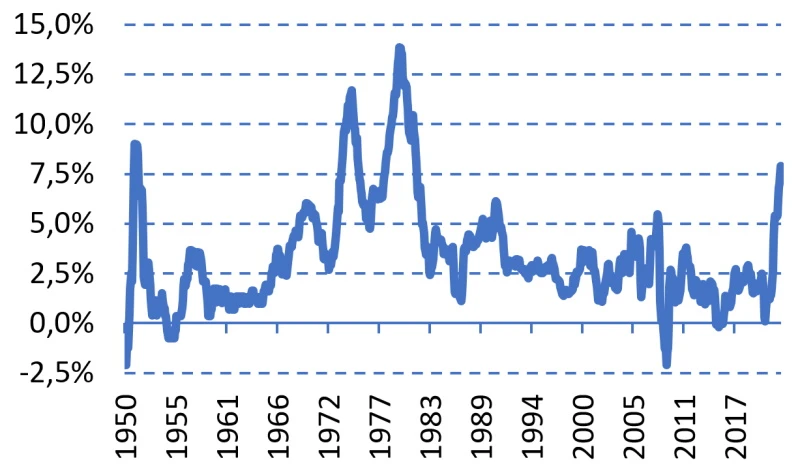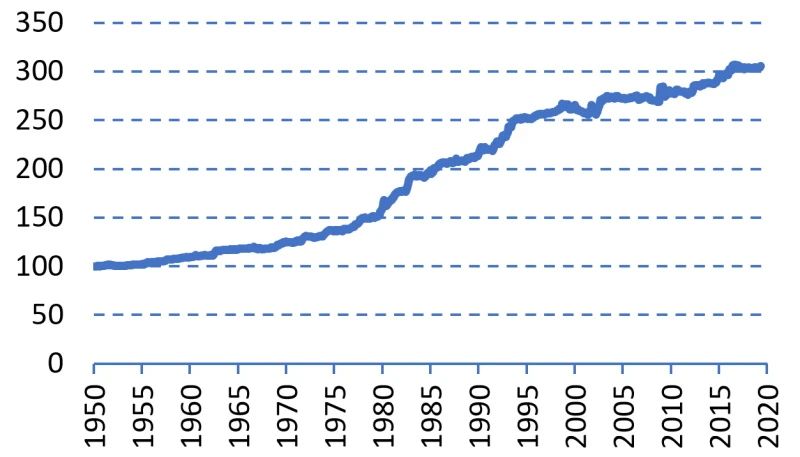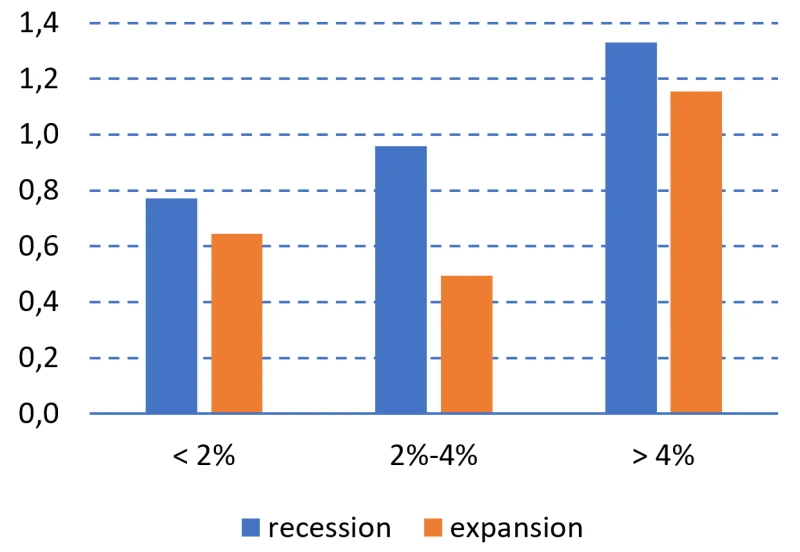Stagflation is hitting the headlines again: high inflation and central bank tightening are already leading to rising yields and negative bond returns. At some point, though, higher yields and weaker growth will begin to offer opportunities for bond investors. To capture these opportunities when they arise, while also protecting portfolios against rising yields, active duration management is needed. But how do we know whether a strategy that was successful in recent decades will also work in a completely different environment?
To answer this question, we use the long-term back-test described in our academic paper ‘Predicting Bond Returns: 70 Years of International Evidence’. The back-test demonstrates that quant duration management works in an environment of high inflation and weak growth. Typically, it works best when bond markets move most – a positive finding given that the current environment is likely to cause significant market moves.
Stagflation risk has risen
The risk of stagflation is clear as commodity prices have surged due to the war in Ukraine, and energy supply is threatened. US inflation has already reached levels unseen since the early 1980s and growth will be weaker as high energy prices hurt disposable income and force energy-intensive companies to reduce their production. Strict lockdowns are again implemented in economically important parts of China, while Covid-related supply chain disruptions and chip shortages are already limiting growth. Fiscal policy might cushion demand, but the resulting higher bond issuance could push yields even higher. Monetary policy has supported the growth rebound from the 2020 lows, but this support is now being withdrawn.
Back-test using a deep historical dataset
Robeco’s Dynamic Duration strategy aims to protect against rising yields and benefit from declining yields. Since its inception in 1998, the duration positioning of this strategy has been determined by a quantitative model. When the research leading to the creation of this model was performed in the early 1990s, the limited availability of historical bond market data was one of the challenges. Most academic research on bond market timing uses data sets starting in the early 1980s, a period characterized by a secular decline in interest rates. Periods of high inflation or stagflation are rare in these data sets and, as a result, evidence for bond market timing in such conditions was scarce.
In recent years, however, a much wider set of historical financial market data has been made available, thanks to researchers digitalizing archives of exchanges, central banks and newspapers. We recently published a paper in which we present evidence for bond market timing using a deep historical dataset. This back-test includes decades with higher inflation and periods of stagflation. In this article, we use the dataset from that paper to analyze the performance of bond market timing in different growth and inflation regimes, including periods of stagflation.
Figure 1 | US inflation, 1950 – February 2022

Source: Bloomberg, Datastream, Global Financial Data
Figure 1 shows the development of US inflation from 1950, and we can see immediately why we need to examine more than just the most recent decades: current inflation is higher than anything seen since the early 1980s. The combination of high inflation (above 4%) and a recession is very rare in recent decades, occurring in less than 5% of the time after 1982.
Our deep sample allows us to better study stagflationary environments: these occurred 23% of the time in the 1950-1982 period, mainly between the late 1960s and the early 1980s. We use a global dataset that includes six large bond markets (the US, UK, Germany, Japan, Australia and Canada) to study bond market timing all the way back to 1950.
最新のインサイトを受け取る
投資に関する最新情報や専門家の分析を盛り込んだニュースレター(英文)を定期的にお届けします。
Performance in times of stagflation
Our academic paper shows that bond market returns can be predicted using a combination of four variables: bond trend, yield spread, equity return and commodity return. This finding is robust over markets and over time periods. Figure 2 shows the cumulative back-tested performance of this strategy.
Figure 2 | Cumulative back-tested performance, 1950-2019

Source: Robeco
This figure indicates that the back-tested performance is good in the period with rising yields before 1982, as well as in the period of the secular decline in yields after that. In the paper, we provide formal evidence that the strategy’s performance is good in both these sub-periods, in recessions and expansions, and in periods of high inflation and low inflation.
In this article, we now take that analysis one step further by classifying periods based on a combination ofgrowth and inflation. We distinguish periods with low, moderate and high inflation (below 2%, between 2% and 4%, and above 4%) in recessions, and do the same for expansions (following the same classification of recessions as in our academic paper). Figure 3 shows the model performance in these 3 x 2 = 6 categories.
Figure 3 | Model Information ratio in times of recession and expansion, and different inflation levels

Source: Robeco. Period: 1950-2019
The blue bars denote the information ratio of the bond market predictability strategy in recession periods, the grey bars in periods of expansion, with the bars (from left to right) showing the results in periods with low, moderate and high inflation. The figure shows that the back-tested strategy worked in all environments. Bond market predictability is especially strong in periods of stagflation, where inflation is high in a recession.
Adding most value when markets move most
The strategy’s strong performance in times of stagflation is in line with the academic paper’s general conclusion that the strategy also works well in adverse economic and market environments, for example in periods with falling equity markets. Typically, the model generates most return when bond markets move most – also because its signals are more reliable (higher success ratio) in periods when markets move strongly. The Dynamic Duration strategy has also generated above-average outperformance in the periods with the largest moves in bond markets (for up as well as down moves) throughout its 24-year live track record.
The current environment combines several potential drivers of strong moves in bond markets: high inflation, central bank tightening and increased bond issuance (to fund investments in defense and alternative energy supply) could push yields higher, while these higher yields and downside risks to growth could also offer opportunities for bond investors. Dynamic duration management can help to navigate these markets, both to offer protection against rising yields and to benefit when bonds rally again. The deep-sample back-test described in our academic paper shows that bond market timing works well in adverse environments, including during periods with high inflation and low growth.
重要事項
当資料は情報提供を目的として、Robeco Institutional Asset Management B.V.が作成した英文資料、もしくはその英文資料をロベコ・ジャパン株式会社が翻訳したものです。資料中の個別の金融商品の売買の勧誘や推奨等を目的とするものではありません。記載された情報は十分信頼できるものであると考えておりますが、その正確性、完全性を保証するものではありません。意見や見通しはあくまで作成日における弊社の判断に基づくものであり、今後予告なしに変更されることがあります。運用状況、市場動向、意見等は、過去の一時点あるいは過去の一定期間についてのものであり、過去の実績は将来の運用成果を保証または示唆するものではありません。また、記載された投資方針・戦略等は全ての投資家の皆様に適合するとは限りません。当資料は法律、税務、会計面での助言の提供を意図するものではありません。 ご契約に際しては、必要に応じ専門家にご相談の上、最終的なご判断はお客様ご自身でなさるようお願い致します。 運用を行う資産の評価額は、組入有価証券等の価格、金融市場の相場や金利等の変動、及び組入有価証券の発行体の財務状況による信用力等の影響を受けて変動します。また、外貨建資産に投資する場合は為替変動の影響も受けます。運用によって生じた損益は、全て投資家の皆様に帰属します。したがって投資元本や一定の運用成果が保証されているものではなく、投資元本を上回る損失を被ることがあります。弊社が行う金融商品取引業に係る手数料または報酬は、締結される契約の種類や契約資産額により異なるため、当資料において記載せず別途ご提示させて頂く場合があります。具体的な手数料または報酬の金額・計算方法につきましては弊社担当者へお問合せください。 当資料及び記載されている情報、商品に関する権利は弊社に帰属します。したがって、弊社の書面による同意なくしてその全部もしくは一部を複製またはその他の方法で配布することはご遠慮ください。 商号等: ロベコ・ジャパン株式会社 金融商品取引業者 関東財務局長(金商)第2780号 加入協会: 一般社団法人 日本投資顧問業協会
